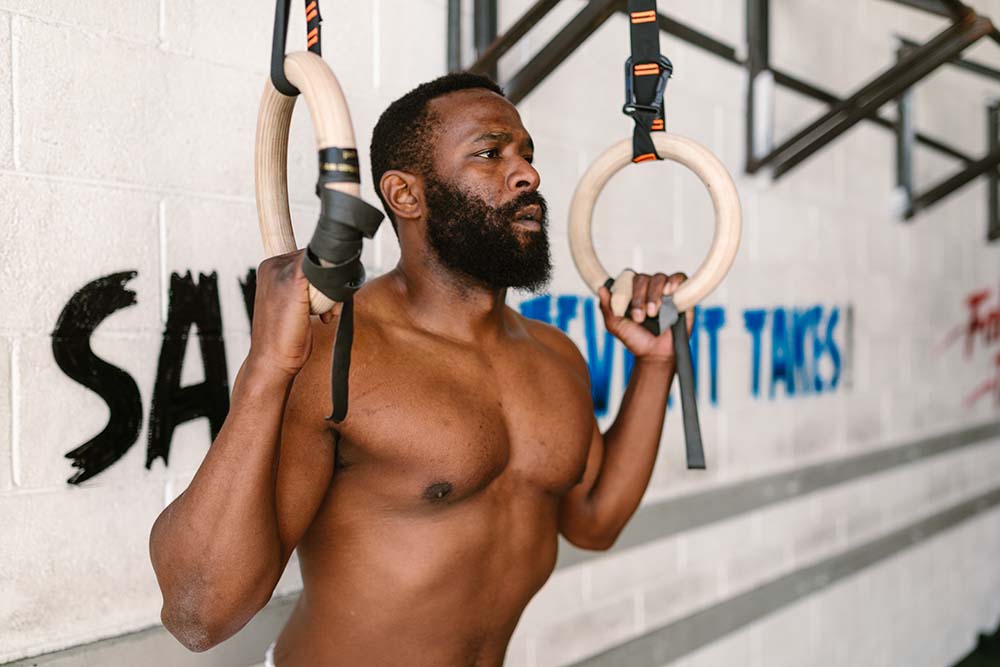16 Gymnastic Rings Exercises for Beginners & Seasoned Gymnasts

In this post we take a look at 16 of the best gymnastic rings exercises, from beginner right up to advanced.
Gymnastic rings are often used in calisthenics as a bodyweight workout tool and they’re also popular in CrossFit workouts. Doing compound movements with limited stability reaps huge benefits in terms of strength, balance and muscular development.
Use the exercises in this guide to get started with gymnastic rings training and gradually move on to the more advanced exercises when you’re ready.
Let’s begin.
Table of Contents
ToggleWhy Workout with Gymnastic Rings?
The benefits of calisthenics over normal weight training are the result of doing large, compound strength movements while exerting a constant effort to maintain form and stability. Working out with gymnastic rings takes that a step further.
When you do calisthenics exercises with rings, you’re forced to engage a whole new set of stabilizing muscles. Since the rings move freely, the level of muscle activation is far more intense than if you were holding onto a fixed bar.
Adding gymnastic rings to your calisthenics training equipment is awesome if you want to add variety to your workout, keep your muscles guessing and keep piling on the gains.
Gymnastic Rings Exercises for Beginners
1. Ring Rows
The ring row motion is similar to that of proper rowing and you can adapt the difficulty according to your level of ability with gymnastic rings workouts. The closer you are to a standing position, the easier the exercise.
2. Ring Push Ups
The lack of stability in the rings means that ring push ups are more difficult than standard floor push ups. You’ll use a greater range of muscles to keep your body in the correct position. As with ring rows, the higher your hands, the easier the exercise.
3. Assisted Dips

Ring dips are a popular gymnastic ring exercise that build the triceps and can be used by beginners to advanced athletes. You can do assisted dips by leaving your feet on the floor (or a plyo box) so that they take some of the weight and also provide greater stability. You can also use calisthenics resistance bands to do assisted dips.
4. Bicep Curls
So called because your arm position and movements replicate a bicep curl. This exercise can be performed single-handed or with both hands. The ring bicep curl is a great isolation exercise for building up your bicep muscles.
5. Ring Support Hold
The ring support might look easy at first glance, but it is similar to the plank in that it won’t take long before your body begins to feel the pressure while holding the pose. The ring support tests straight arm strength, improves stability, and is essential to progressing your ring training skills.
Intermediate Gymnastic Ring Exercises
6. Ring Pull Ups
Ring pull ups are great for back day and being able to rotate your hands and arms while you do the exercise gives gymnastic rings an extra advantage over pull up bars.
7. Ring Flyes
Ring flyes workout your chest, arms and shoulders, and the difficulty lies in keeping your arms straight throughout the movement. Although flyes can be considered a chest isolation exercise, doing them with rings requires an intense level of muscle activation in your arms and shoulders too.
8. L-Sit
The L-Sit starts in a ring support position but requires you to lift your legs until they are perpendicular to your hips, but without bending your knees. It exercises your abdomen as well as your arms and shoulder, and even placing some tension on the legs.
9. Dips
Starting from a support position, the dip requires that you lower yourself so that your shoulders are below the height of your elbows. The exercise works the whole upper body and requires that you maintain good stability throughout.
10. Toes To Rings
Toes to rings, also known as toes through rings, are a major challenge for your core muscles. The ultimate aim of the exercise, as you progress and get stronger, is to get your toes through the rings. Make sure you use muscular strength to lift your legs, rather than swinging for momentum.
11. Tricep Extensions
A ring-based variation of the tricep extension or French press, this exercise obviously works the triceps but also hits the core and glutes. The higher your hands, the easier the exercise, so this is another one that can be tailored to your skill.
Advanced Exercises With Gymnastic Rings
12. Muscle Up
Muscle ups are difficult enough with a bar, so using rings is a major challenge. There are a variety of ways to perform them, but strict muscle ups require that you use your muscle power (instead of momentum) to pull up into a dip.
13. Skin The Cat
You start skinning the cat by hanging from the rings before rotating through your arms, touching the floor with your feet, and then potentially returning to a German hang position. Start slowly and build up to more advanced variations.
14. Front Lever
The front lever takes a lot of training to achieve, requiring amazing core, shoulder and back strength. The body should remain straight as long as you hold the exercise – a lot harder than it looks.
15. Back Lever
Like the front lever, the back lever requires a super strong core, and also activates your shoulders intensely. It can be slightly easier than the front level but still represents a serious gym ring achievement.
16. Forward Roll
The forward roll takes a lot of control and strength, at least when done correctly. You start at the top of a dip and perform a roll over the rings. You need to be able to do muscle-ups before you can attempt forward rolls.
Training Tips
As mentioned, using gymnastic rings in your workout is difficult and requires serious determination to master. It’s a good idea to start off using easier calisthenics equipment and only start using rings once you’ve had some experience with a fixed pull up bar.
As with any difficult workout, the best advice is to always go slowly. Let your muscles gradually get used to the easier exercises before you move on to more difficult movements. This is the best way to make steady progress and avoid injury.
You can also use pull up bands to assist you with the more difficult movements. Here’s a video showing you how to use them for assisted pull ups:

